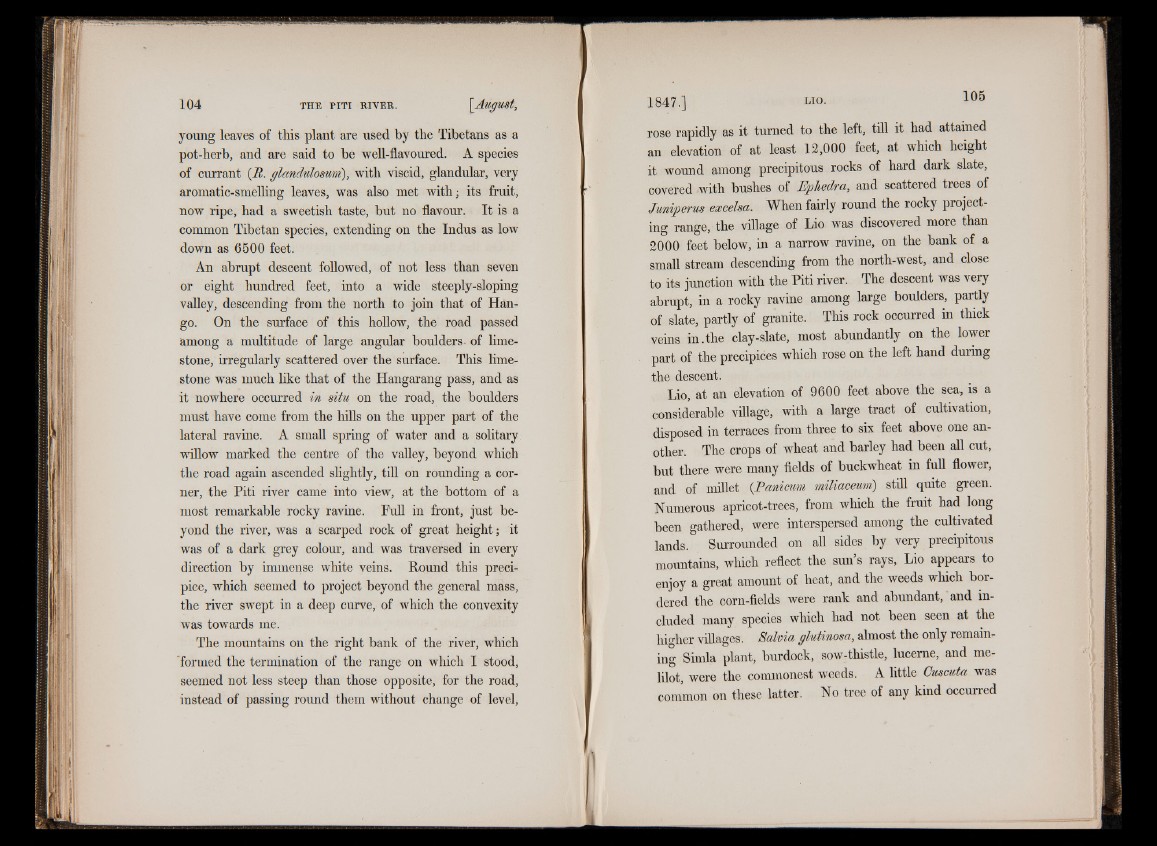
young leaves of this plant are used by the Tibetans as a
pot-herb, and are said to be well-flavoured. A species
of currant (R. glandulosum), with viscid, glandular, very
aromatic-smelling leaves, was also met with; its fruit,
now ripe, had a sweetish taste, but no flavour. It is a
common Tibetan species, extending on the Indus as low
down as 6500 feet.
An abrupt descent followed, of not less than seven
or eight hundred feet, into a wide steeply-sloping
valley, descending from the north to join that of Han-
go. On the surface of this hollow, the road passed
among a multitude of large angular boulders- of limestone,
irregularly scattered over the surface. This limestone
was much like that of the Hangarang pass, and as
it nowhere occurred in situ on the road, the boulders
must have come from the hills on the upper part of the
lateral ravine. A small spring of water and a solitary
willow marked the centre of the valley, beyond which
the road again ascended slightly, till on rounding a corner,
the Piti river came into view, at the bottom of a
most remarkable rocky ravine. Full in front, just beyond
the river, was a scarped rock of great height; it
was of a dark grey colour, and was traversed in every
direction by immense white veins. Round this precipice,
which seemed to project beyond the general mass,
the river swept in a deep curve, of which the convexity
was towards me.
The mountains on the right bank of the river, which
formed the termination of the range on which I stood,
seemed not less steep than those opposite, for the road,
instead of passing round them without change of level,
rose rapidly as it turned to the left, till it had attained
an elevation of at least 12,000 feet, at which height
it wound among precipitous rocks of hard dark slate,
covered with bushes of Ephedra, and scattered trees of
Juniperus excelsa. When fairly round the rocky projecting
range, the village of Lio was discovered more than
2000 feet below, in a narrow ravine, on the bank of a
small stream descending from the north-west, and close
to its junction with the Piti river. The descent was very
abrupt, in a rocky ravine among large boulders, partly
of slate, partly of granite. This rock occurred in thick
veins in.the clay-slate, most abundantly on the lower
part of the precipices which rose on the left hand during
the descent.
Lio, at an elevation of 9600 feet above the sea, is a
considerable village, with a large tract of cultivation,
disposed in terraces from three to six feet above one another*
The crops of wheat and barley had been all cut,
but there were many fields of buckwheat in full flower,
and of millet {Panicum miliaceum) still quite green.
Numerous apricot-trees, from which the fruit had long
been gathered, were interspersed among the cultivated
lands. Surrounded on all sides by very precipitous
mountains, which reflect the sun’s rays, Lio appears to
enjoy a great amount of heat, and the weeds which bordered
the corn-fields were rank and abundant, and included
many species which had not been seen at the
higher villages. Salvia glutinosa, almost the only remaining
Simla plant, burdock, sow-thistle, lucerne, and me-
lilot, were the commonest weeds. A little Cuscuta was
common on these latter. No tree of any kind occurred